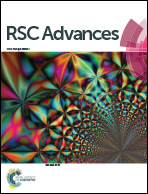Fused tetracyclic tris[1,2,4]triazolo[1,3,5]triazine as a novel rigid electron acceptor for efficient thermally activated delayed fluorescence emitters†
Abstract
Tris[1,2,4]triazolo[1,3,5]triazine, a new acceptor based on a fused triazole and triazine moiety, is utilized to construct D3–A star-shaped tristriazolotriazine derivatives, named 3,7,11-tris(4-(10H-phenoxazin-10 yl)phenyl)tris([1,2,4]triazolo)[1,3,5]triazine (TTT-PXZ) and 3,7,11-tris(4-(9,9-dimethylacridin-10(9H)yl)phenyl)tris([1,2,4])triazolo[1,3,5]triazine (TTT-DMAC). Both TTT-PXZ and TTT-DMAC emitters feature TADF activities and AIEE properties. Consequently, solution processed OLEDs based on TTT-PXZ green emitters exhibited good performances, with an external quantum efficiency (EQE) of up to 6.2%.
![Graphical abstract: Fused tetracyclic tris[1,2,4]triazolo[1,3,5]triazine as a novel rigid electron acceptor for efficient thermally activated delayed fluorescence emitters](/en/Image/Get?imageInfo.ImageType=GA&imageInfo.ImageIdentifier.ManuscriptID=D0RA01925A&imageInfo.ImageIdentifier.Year=2020)


 Please wait while we load your content...
Please wait while we load your content...